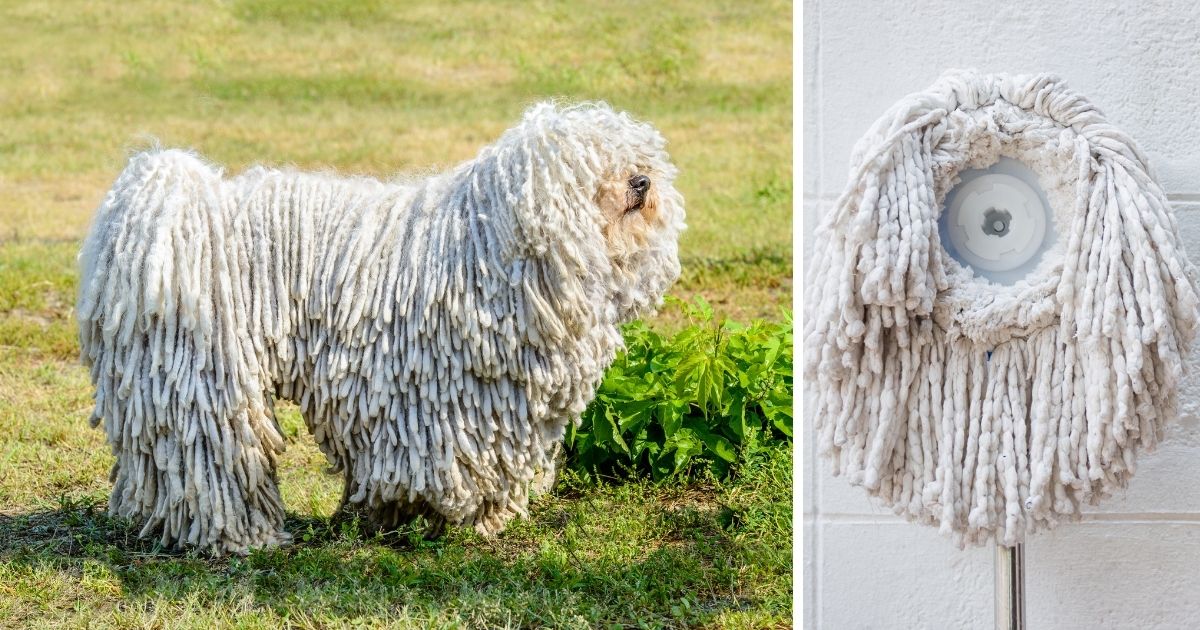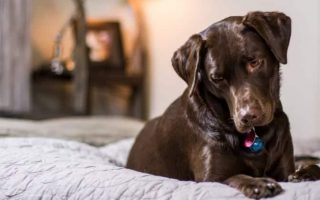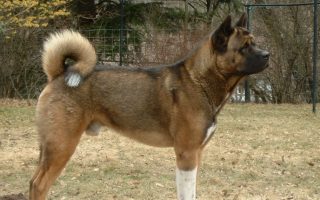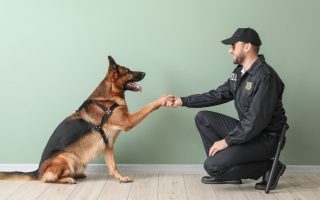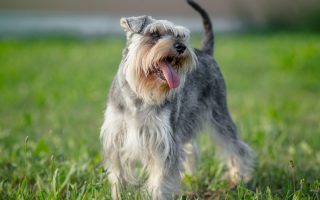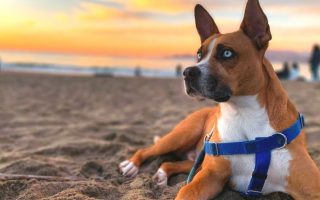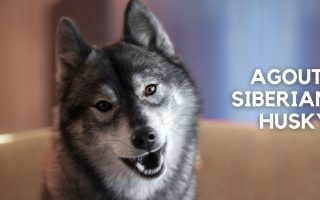We’ve come across many weird-looking dogs, and that may be what you’re into.
Nothing beats the feeling of seeing strangers take a step back and say ‘is that a dog?’ at the sight of your pooch. It may not be easy to find these dogs, but it sure is worth it.
Dogs with dreadlocks or curly, long hair have to be some of the craziest looking out there.
From their shaggy looks to their exceptional fur, you may feel like cracking up some reggae at the sight of them.
Most of these are dogs that look like mops when lying down, so we won’t judge if you try to grab your doggy to clean up the kitchen. It happens to the best of us.
If you like your pets looking different from the conventional ones, then you should get one of these dogs. You would have to deal with the hair, but that comes with the territory.
Let’s take a look at some of the shaggiest, mop-like looking dogs with fanciful dreads and interesting stories, right after we understand how they become this way.
Is it a Dog or a Mop?
As we said, we won’t judge you if you mistake these dogs for mops. There’s a reason they are called mop dogs, after all.
All mop dogs don’t belong to a particular breed, neither are they classified as a type. However, they share a similar physical characteristic, namely their coat.
A dog that looks like a mop become that way either naturally or through the intentional effort of their owners.
The natural process happens when the undercoat and topcoat combine, resulting in round, rope-like cords.
Mop dogs may also get curly hair which will naturally mat, or combine to form felt-like textures.
The good news is, many of them hardly shed. You only need to take care of the hair.
Mop dogs are also cute! Few things beat the beauty of these pooches.
As a pet owner, you will get used to people cooing and reaching out to touch the hair.
Here are 15 pawfect and adorable mop dogs and dogs with dreads — one of which may catch your fancy.
Dogs that Look Like Mops (Some are Dogs with Dreadlocks & Long Hair)
1. Komondor
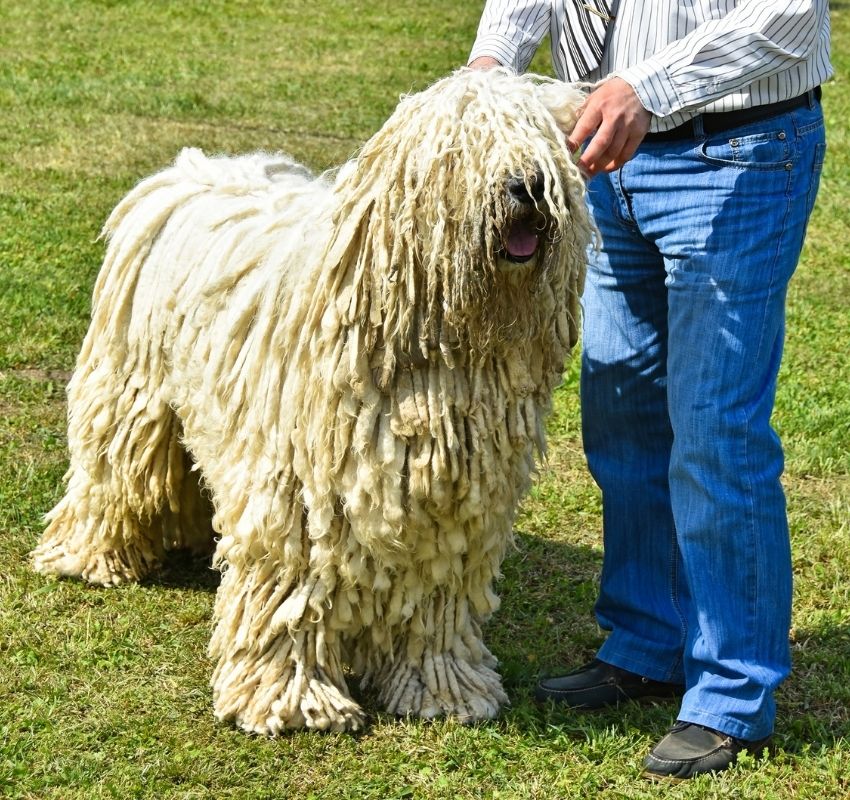
- Life Span: 10–12 years
- Height: Male 27.5 in; Female 25.5 in
- Weight: Male 110–132 lbs; Female 88–110 lbs
- Temperament: Calm, gentle, affectionate, steady, independent, fearless
- Country of Origin: Hungary
Komondor is one of the most popular mop dogs. Hence, they get the honor of being the first on our list.
This breed was developed in Hungary to guard sheep against wolves and other predators, which means there is a fighter underneath those dreads.
Their coat served as a sweater due to the harsh Hungarian weather, and as armor against the sharp teeth of wild predators.
It also helped them blend amongst sheep, giving these guard dogs the perfect disguise against unsuspecting wolves. Talk about a dog in sheep’s clothing.
Their guard dog nature makes them loyal and protective of their families.
Komondors don’t take intruders lightly and also play a good watchdog role by barking when someone strange approaches. Barking aside, they are often calm and gentle.
You should ensure their wariness of strangers doesn’t turn to aggression, as people will be curious about your Komondor. These dogs are also not the best bet for a multiple-dog household.
Komondor is an ancient breed, with early records dating back to the 16th century. It is believed that they descended from Owtcharka, a Russian breed.
World War 2 had a severe impact on Komondor, getting this breed to the edge of extinction.
Fortunately, breeders worked to restore them, but they remain rare. They were recognized by the American Kennel Club (AKC) in 1937.
2. Bergamasco Sheepdog
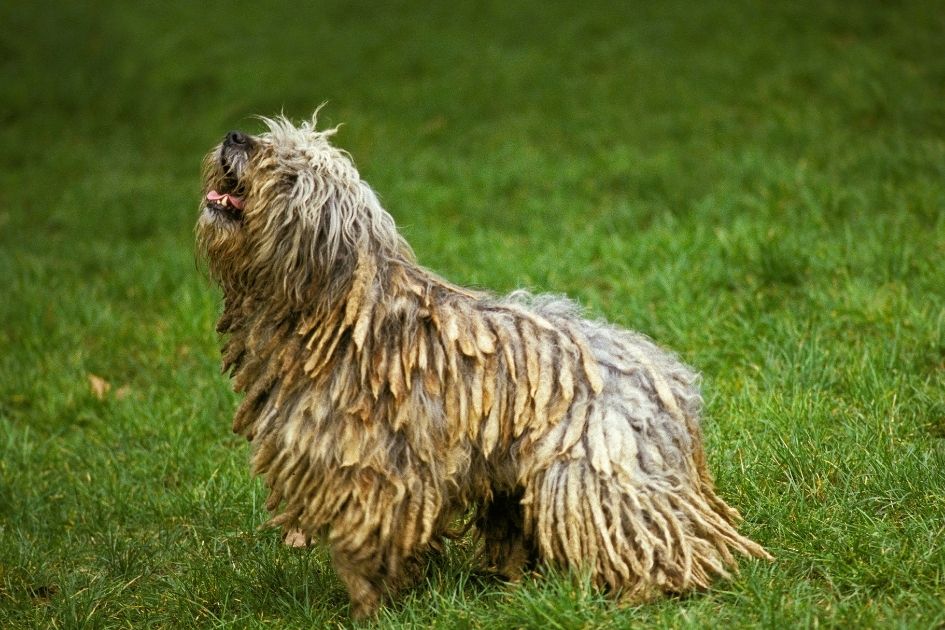
- Life Span: 13–15 years
- Height: Male 23–24 in; Female 21–23 in
- Weight: Male 71-84 lbs; Female 57-71 lbs
- Temperament: Patient, intelligent, determined, alert
- Country of Origin: Italy
Bergamasco Sheepdog looks similar to the Komondor and may even be confused for the Hungarian doggy.
They differ in the structure of their cords but were bred for similar roles of guarding sheep. Their coats combine three types of hair: goats, wool, and dog.
So many qualities make this dog breed adorable, and it isn’t only the coat. Their calm demeanor and sense of intuition make them loved by people around them.
The cliche of patient dogs and fat bones is appropriate to describe them, as patience is one of their best attributes.
They are both independent and obedient, a paradox that works well for these doggies.
The qualities of patience, calmness, and intuition make the Bermagasco Sheepdog a good therapy dog. He is also good with children and tends to be protective of them.
The major weakness of a Bermagasco dog is the aforementioned independence. This makes them rebellious sometimes, so you should be firm.
Furthermore, they may take their protectiveness too far, so you need to socialize them properly.
Bergamasco Sheepdogs are also oldies, going as far back as 7,000 years. The breed got its name from Bergamo, an Italian city.
World War 2 dwindled the number of Bergamasco Sheepdogs, and they are rare today.
The Fédération Cynologique Internationale (FCI) first recognized the breed in 1956. In 2015, the AKC took the baton.
3. Poodle
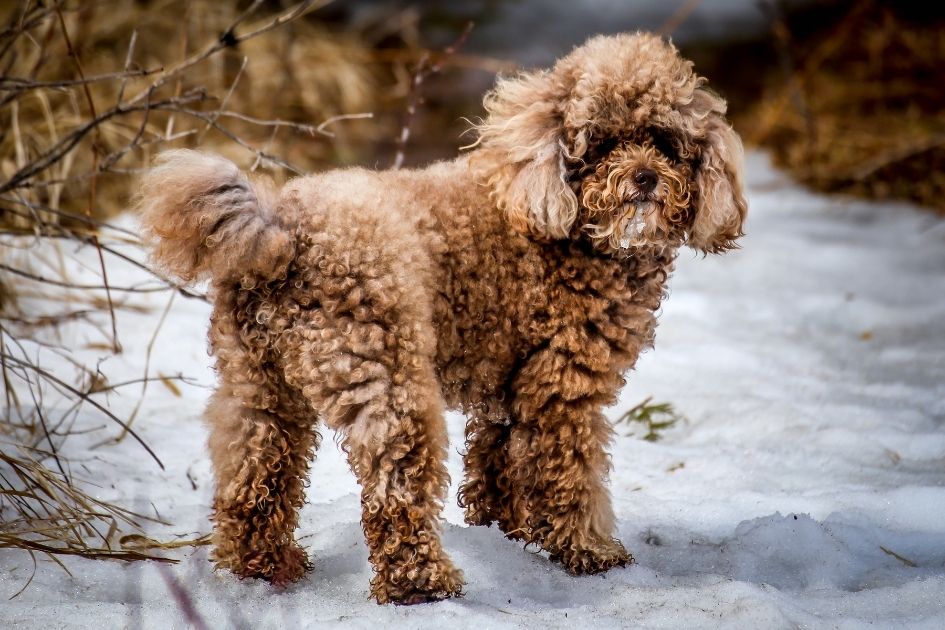
- Life Span: 12–15 years
- Height: (Standard Male & Female) 18–24 in
- Weight: (Standard) Male 60–70 lbs; Female 40–50 lbs
- Temperament: Faithful, active, intelligent, alert, trainable
- Country of Origin: Germany/France
Okay, so we did say Komondor is one of the most popular dogs with dreadlocks. However, the only advantage Komondors have over poodles is the natural nature of their cords.
Poodles aren’t bred looking like a mop, but their curly hairs can tangle.
Poodle is a very popular dog breed, and the name is a go-to term when talking about elegant dogs. Elegance is a common trait for these fine dogs, and they strut like royalty.
Don’t let their fanciful looks fool you, though. Poodles aren’t lazy dogs whose favorite activity is sleeping.
They were developed to be water retrievers, and that is a hard job of its own. They also make excellent athletes and are easy to train.
Do not also imagine that poodles are uptight. On the contrary, they love to make friends and warm up around strangers. They love to play with family and don’t do well alone.
Having said that, there is a tendency for pet parents to spoil poodles (blinded by the beauty, perhaps).
This has repercussions as they may end up acting like they own the place.
There are three sizes of poodles: toy, miniature, and standard.
There is a little controversy about the poodle’s origin, but many believe this breed started in Germany and became independent in France. In 1874, they were recognized by the Kennel Club in England.
The AKC recognized them in 1886. While the second world war affected them, they quickly rose to the ranks of the most popular dogs in the United States.
4. Puli
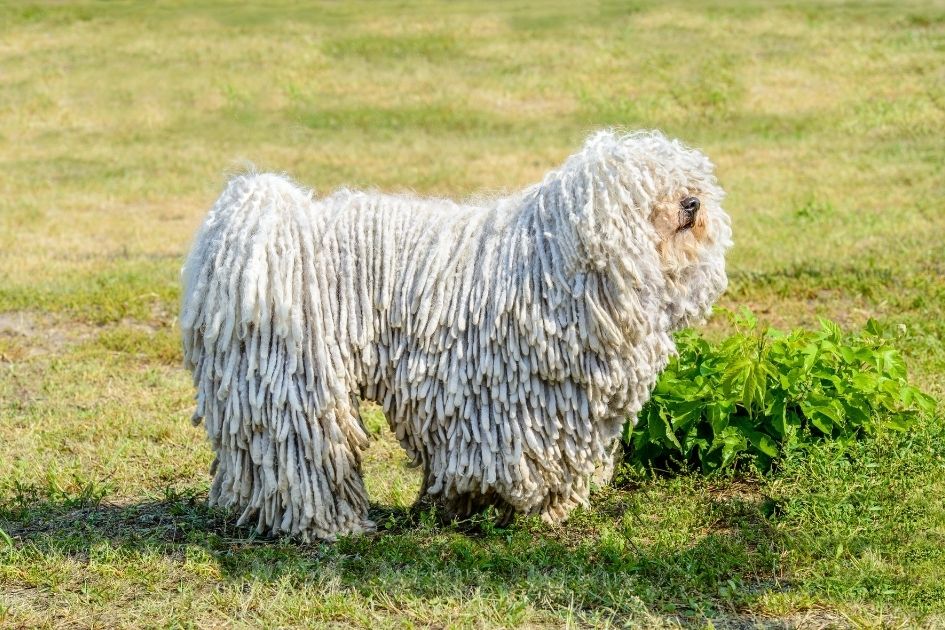
- Life Span: 12–15 years
- Height: Male 17 in; Female 16 in
- Weight: Male 30–35 lbs; Female–30 lbs
- Temperament: Agile, loyal, energetic, intelligent, faithful
- Country of Origin: Hungary
Komondor and Puli got some close ties. One could call them siblings, or first cousins at the very least.
Puli has a different career path, however. While Komondors guarded sheep, Pulik (the plural of Puli) herded them.
Puli dogs are known for their loyalty and their high level of intelligence, common traits many herder dogs have. They’ve got surprising agility which makes them leap around like an acrobat, and this makes them good athletes.
They are playful with family members and don’t turn down opportunities for fun, so be ready to keep them entertained.
This dog breed loves to bark and will do so at the sight of anything strange.
While this makes them good watchdogs, make sure your neighbors don’t mind a barking dog. Alternatively, you can train your Puli to bark on command.
They also need the training to tame that strong will. Pulik are stubborn and used to thinking on their own, so training may not be easy.
They’ll get bored too if you don’t spice up their training program. Another habit that needs to be curbed is their tendency to herd people.
While this isn’t dangerous, it may be frightening to others and a tad annoying.
Pulik have been in existence for a long, like other breeds on this list. When the need for shepherd dogs reduced, so did the number of Puli dogs.
It took the efforts of people like Dr. Emil Raitsits and Adolf Lendl. They were recognized by the FCI in 1924 and got accepted for registration by the AKC in 1936.
5. Havanese
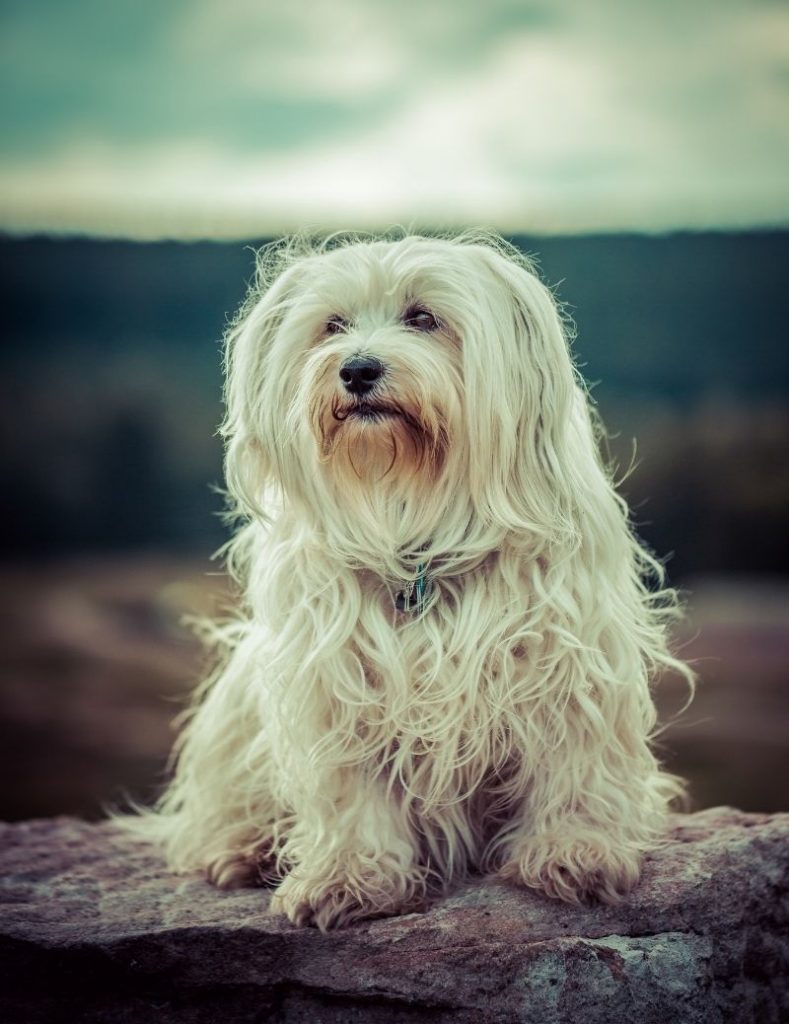
- Life Span: 13–15 years
- Height: Male 8.5–11.5 in; Female 8.5–11.5 in
- Weight: Male 7–13 lbs; Female 7–13 lbs
- Temperament: Affectionate, playful, gentle, intelligent.
- Country of Origin: Cuba
Havanese dogs, like poodles, don’t have natural mop-like cords. However, their curls can tangle enough to achieve the look. This earns them a spot on our list. Plus, they love to cuddle!
The Havanese dog was bred to be a companion, and he plays the role of man’s best friend very well.
His affection isn’t limited to his family, both strangers and cats can join in.
He’s a velcro dog because he loves to stick to a particular person, and forms a strong bond with that individual.
Nevertheless, his skill set doesn’t end at being a companion and cuddle buddy.
Havanese dogs are athletes and hard workers, ready to get off that couch and make moves.
His love for people comes with a particular challenge: loneliness. Havanese dogs love company and may suffer from separation anxiety if they have no companion.
You may not enjoy having one if you’re a busy folk. You shouldn’t also make the mistake of overpampering these dogs.
Some old companion dogs brought by Spanish settlers into Cuba became the foundations of current Havanese dogs.
In some years, Havanese dogs became the sweethearts of Cuba elites. In the western world of the 1800s, the Havanese was once trending.
That faded, and they faced extinction, but soon bounced back. In 1995, the AKC recognized the breed.
6. Spanish Water Dog
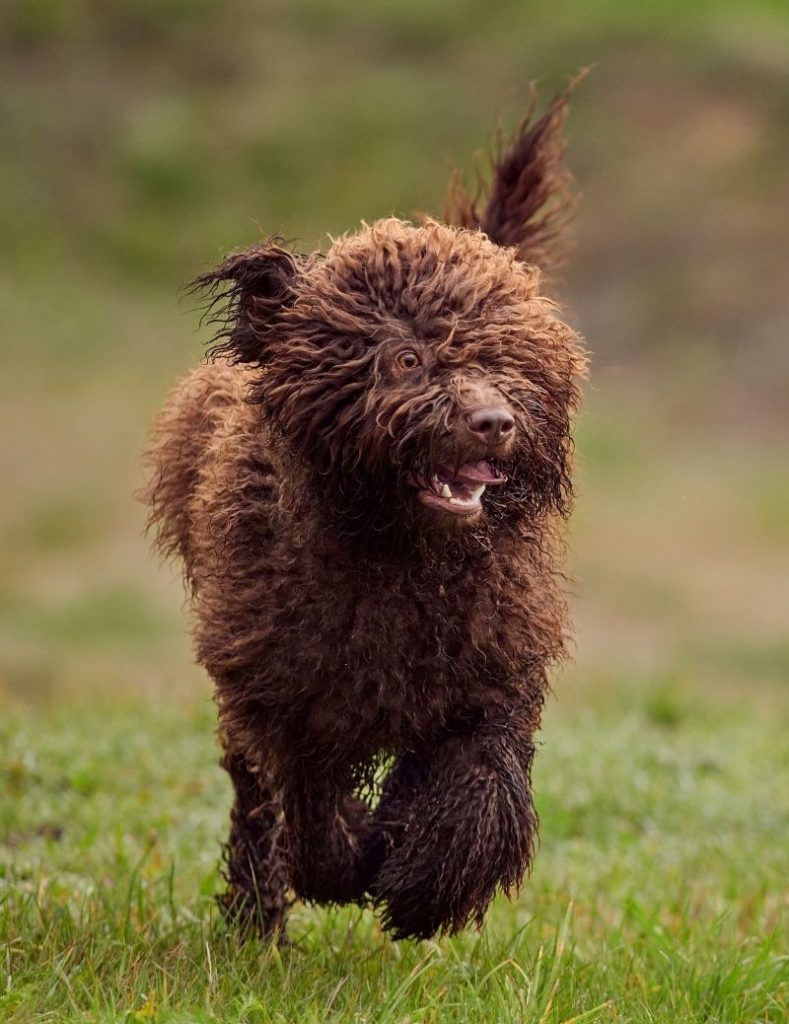
- Life Span: 10–14 years
- Height: Male 17–20 in; Female 16–18 in
- Weight: Male 40–49 lbs; Female 31–40 lbs
- Temperament: Affectionate, playful, gentle, intelligent
- Country of Origin: Spain
Spanish Water Dogs are sometimes interchanged with Portuguese Water Dogs, but there are significant differences between them.
These dogs were bred to be herders, but they played some other roles like guarding and water retrieval.
More importantly, they have the mop dog looks. While the Spanish Water Dog has a single coat, it curls and can grow to become cords.
The good qualities of this breed go beneath the coat, down to their personalities. Spanish Water Dogs are intelligent, active, and strong. If you enjoy hiking, they are excellent companions for you.
Related: Hiking With Dogs: How Do I Prepare My Dog for Hiking?
In addition, they make good guard dogs due to their loyalty and protectiveness. You don’t need to label them as guardians before they take over the role.
They were bred for it. While you sleep, a Spanish Water Dog stays alert for signs of danger.
Their guardian instinct comes with wariness for strangers, and you should make sure it doesn’t become aggression. Socialization is the key to managing this.
Spanish Water Dogs have a blurry origin. What we do know is that they were developed in Spain and we’re multitaskers.
History records that they were on Spanish farmlands for centuries. They were recognized by the AKC in 2015.
7. Afghan Hound
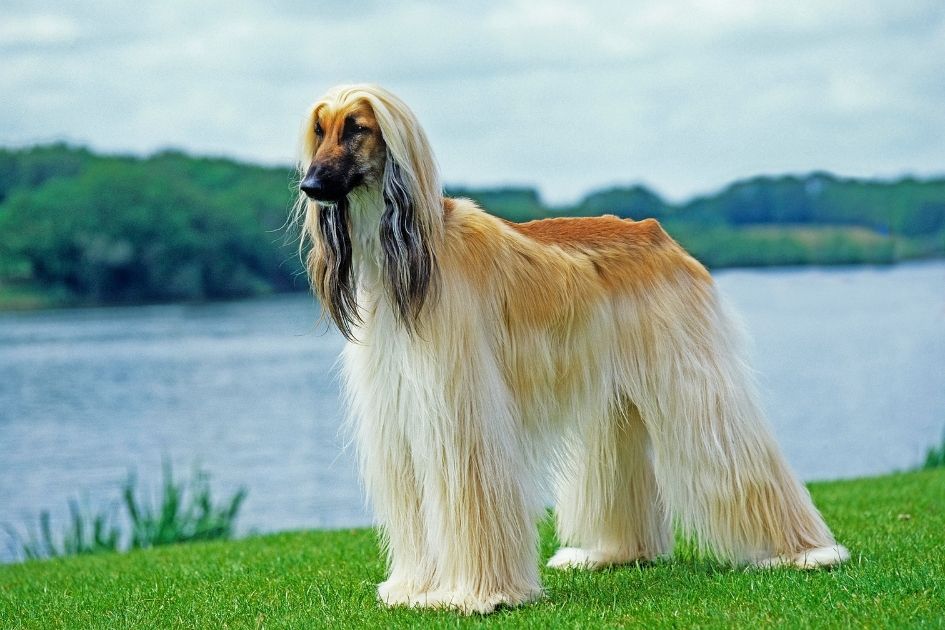
- Life Span: 10 to 12 years
- Height: Male 26 to 27 in; Female 25 to 26 in
- Weight: Male 60 lbs; Female 50 lbs
- Temperament: Dignified, reserved, independent, happy
- Country of Origin: Afghanistan
Afghan Hounds look like graceful celebrities, and they will compete with Poodles for elegance.
Everything about them breathes grace, from their fur to the way they walk. There’s an exception, though. When they lie down, they look a lot like mops (sorry, Afghie).
The graceful and dignified nature of Afghan Hounds makes them aloof, and this isn’t the type of dog that will approach a visitor to befriend.
They aren’t good watchdogs too, because they go out of their way to be alone.
However, it’s a different story with his family. This indifferent dog breed is surprisingly affectionate and friendly, but that’s when he wants to be.
He isn’t the lovey-dovey type, and you may be disappointed sometimes by his unwillingness to play.
This indifference does suit busy people. You don’t have to worry about separation anxiety if you’re not around for long. Do know, however, that it means you have a bigger challenge in training.
Afghan Hounds are not eager to please and may sometimes be stubborn. You must understand the nature of this breed before getting one.
Following the footsteps of other dog breeds on this list, the Afghan Hound is an ancient breed. They were used as hunters of large prey.
They got into the western world in 1925. A year later, the AKC recognized the Afghan Hound.
8. Bearded Collie
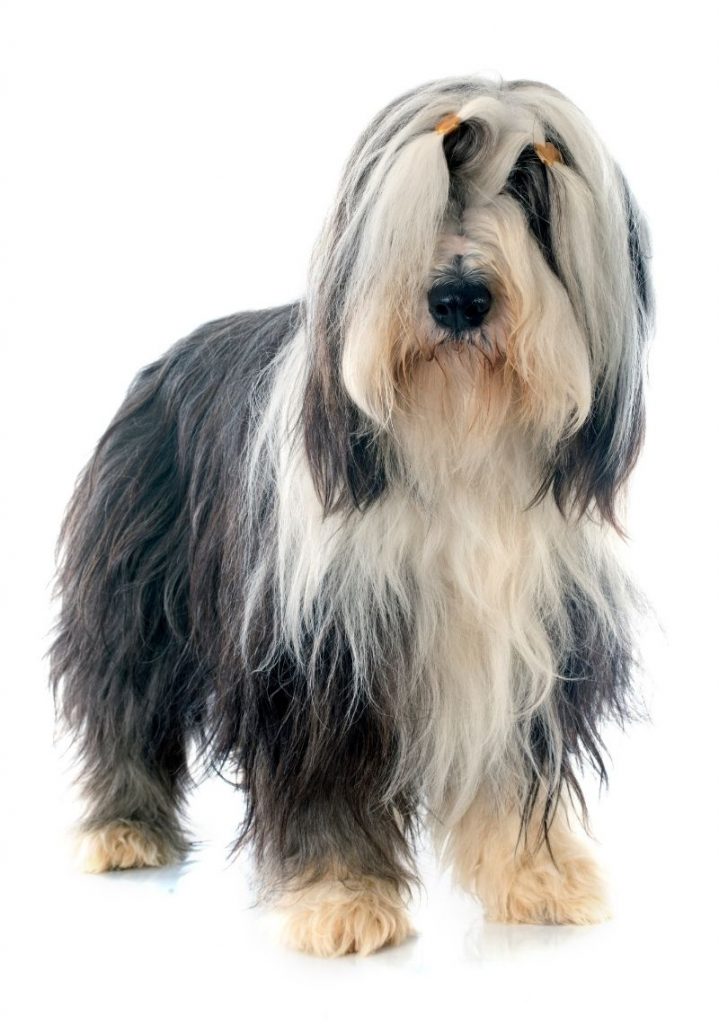
- Life Span: 12–14 years
- Height: Male 21–22 in; Female 20–21 in
- Weight: Male 45–55 lbs; Female 45–55 lbs
- Temperament: Intelligence, lively, alert, active
- Country of Origin: Scotland
Bearded Collies got a massive amount of fur, and there’s no way they won’t make this list. Even their name hints at hair, and you may be confused when you see a Bearded Collie lying down.
This breed is an energetic one, so be ready for lotta exercise with them. They love being active and may get bored with a couch potato.
These dogs are fun lovers and will fill your days with optimism and laughter.
They make excellent playmates for children and will partake in any game offered, as long as they can have fun. Enthusiastic is the middle name of these party dogs.
However, their playful nature doesn’t cancel out the training difficulties you may face, as they can be stubborn.
They need the training to reduce their barking tendencies too, to avoid complaints from neighbors.
The Bearded Collie is regarded as one of the oldest breeds in Britain. The exact origin is unknown, but early paintings of the Bearded Collie dates as far back as 1771.
Modern Bearded Collies were developed after the second world war by a lady who went by the name G.O. Willison.
She formed the Bearded Collie Club in 1955 in Britain. Registration in the AKC began in 1977.
9. Yorkshire Terrier
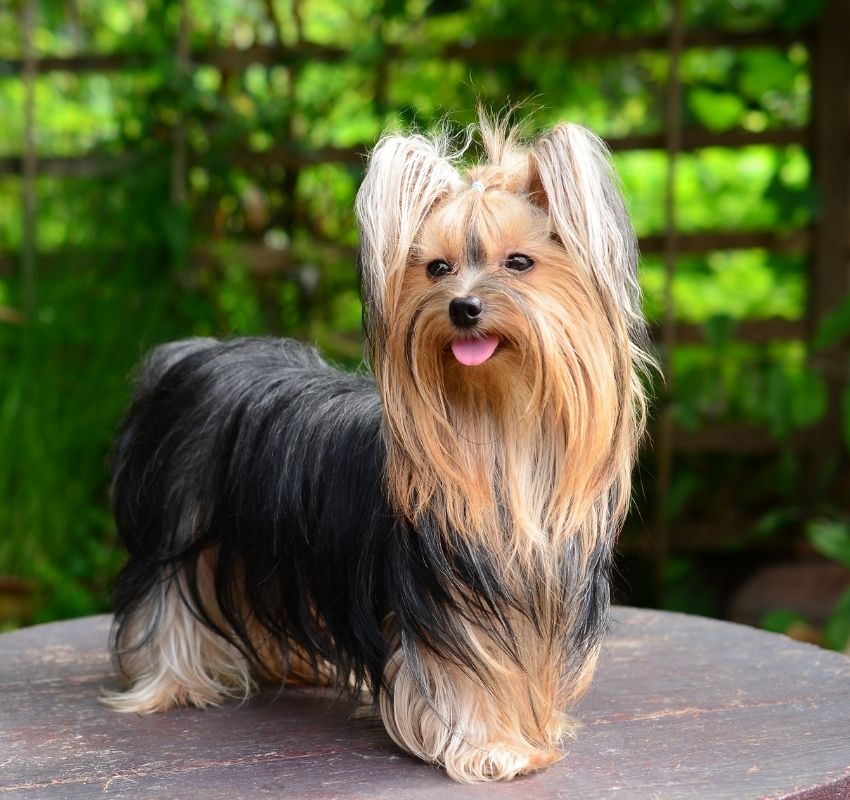
- Life Span: 13–16 years
- Height: Male 8–9 in; Female 8–9 in
- Weight: Male 4–6 lbs; Female 4–6 lbs
- Temperament: Bold, intelligent, independent, confident, courageous
- Country of Origin: England
Yorkshire Terrier got all the qualities that make him a canine celebrity. He’s little and cute, feisty with spunk, and has the shaggy look to attract attention.
This breed is currently one of the most popular breeds in the United States.
The biggest mistake many owners of Yorkshire Terrier make is to underestimate his size. Yorkie has a strong spirit and bravado. He seems to forget he’s a little dog.
Related: Top 15 Dogs With High Prey Drive
It’s all cute when he starts barking at a bigger dog in the dog park, till you see him attack.
Don’t let it get to that level, for his safety. Neither should you spoil him. He may be a star, but he’s still your pet.
Bravado aside, Yorkie has a sensitive side. They don’t do well alone and may get anxious if isolated.
This is a dog you should own only if you don’t mind having a constant companion.
Some challenges you may face, besides the Yorkie’s pride, is his tendency to be noisy. This breed is an attention seeker and will do anything to get the spotlight on him.
Of course, you don’t want your neighbors to be his audience. They may not be fans.
Yorkshire Terriers owe their existence to an older breed named the Clydesdale Terrier. Yorkie was bred as a companion but still retained the Terrier nature.
They were first recognized by the British Kennel Club in 1874.
10. Pekingese
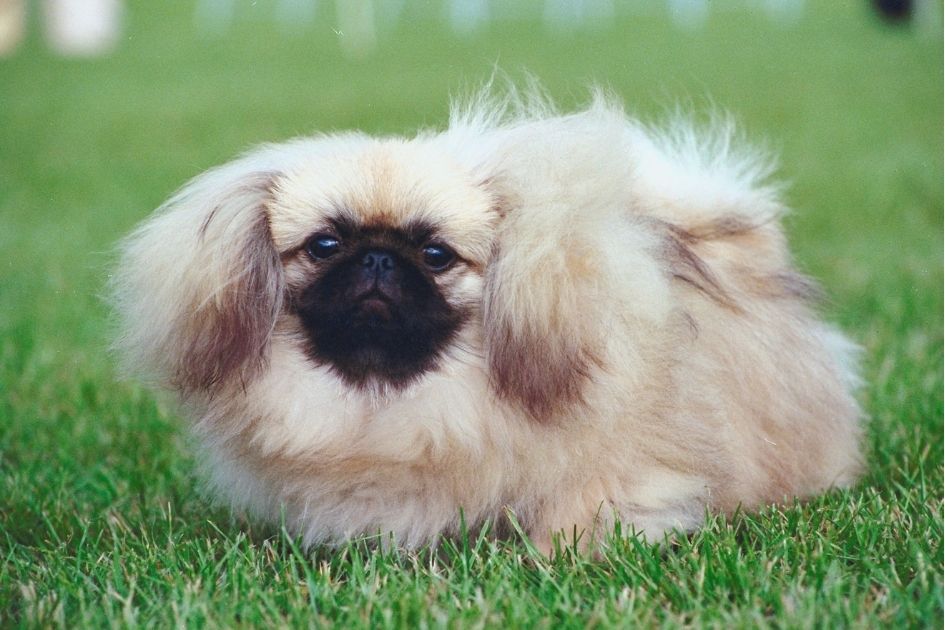
- Life Span: 12 to 15 years
- Height: Male 6 to 9 inches; Female 6 to 9 inches
- Weight: Male 7 to 14 pounds; Female 7 to 14 pounds
- Temperament: Affectionate, aggressive, intelligent, stubborn
- Country of Origin: China
We have many elegant breeds on this list, and the Pekingese have come to join the train. They also have what we want, a pawfect mop-like coat.
The dignity and graceful nature of this breed must have been what made them the royal canine companion of the Imperial family of China.
They can adapt to any environment and are good first-time dogs, which means you won’t find it too difficult to train them.
You should also know that the Pekingese is braver than his size. Though he may not pick a fight like the Yorkshire Terrier, he may not back down from it.
He’s a confident chap with high self-esteem, who’s lively and affectionate as well.
Like other small dogs, do not spoil a Pekingese or you may regret it. You need to be kind but firm with training, and very consistent.
As old as his fellow mop dogs, the Pekingese has been in China for an estimate of 2,000 years. They got registered by the American Kennel Club in 1906.
11. Maltese
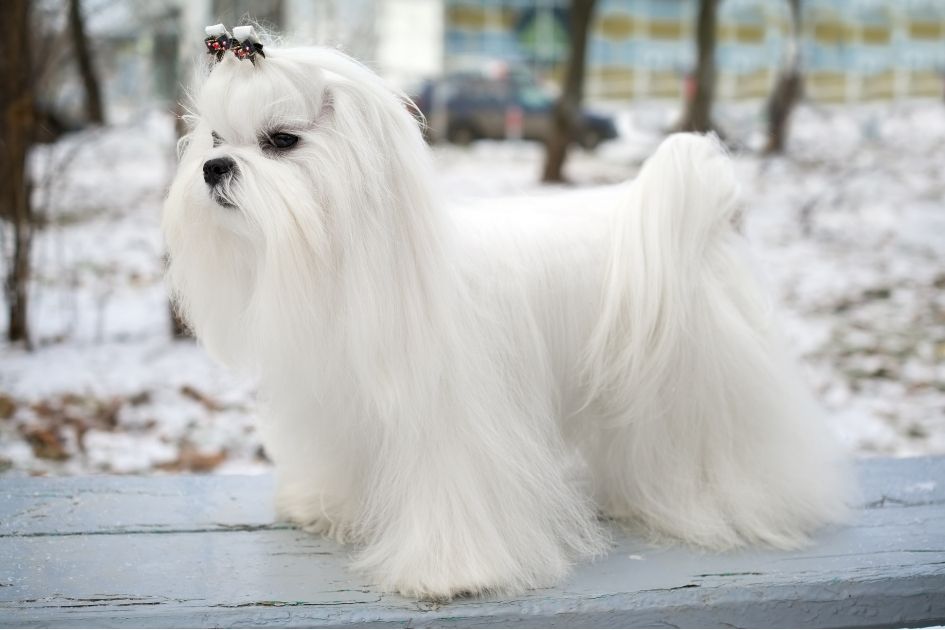
- Life Span: 12–15 years
- Height: Male 8–9 in; Female 8–9 in
- Weight: Male 7 lbs; Female 7 lbs
- Temperament: Intelligent, docile, easygoing, playful, affectionate
- Country of Origin: China
Maltese is a small dog with a white, tangled coat that gives them the desired mop look. They love to cuddle and don’t shed, making them good companions for everyone, including those with allergies.
Maltese dogs love to play, so you should give them enough space to run around and have fun. They may look fragile, but they have a lot of energy to spare.
They are also intelligent and quick to learn, an advantage during training.
Also, these dogs have no reservations against strangers and consider everyone they meet as a friend.
They have a sweet side that draws people to them, and their coat makes for a good discussion with that dog enthusiast at the park.
However, they may not tolerate the excesses of children, so it is not a good idea to have them around little kids.
Also, Maltese dogs do not cope with isolation and may give their owners a hard time training.
Maltese has existed since the early Roman, Greek, and Egyptian cultures, even getting a shout-out from Aristotle. Their registration in the AKC happened during the 1950s.
12. Lhasa Apso
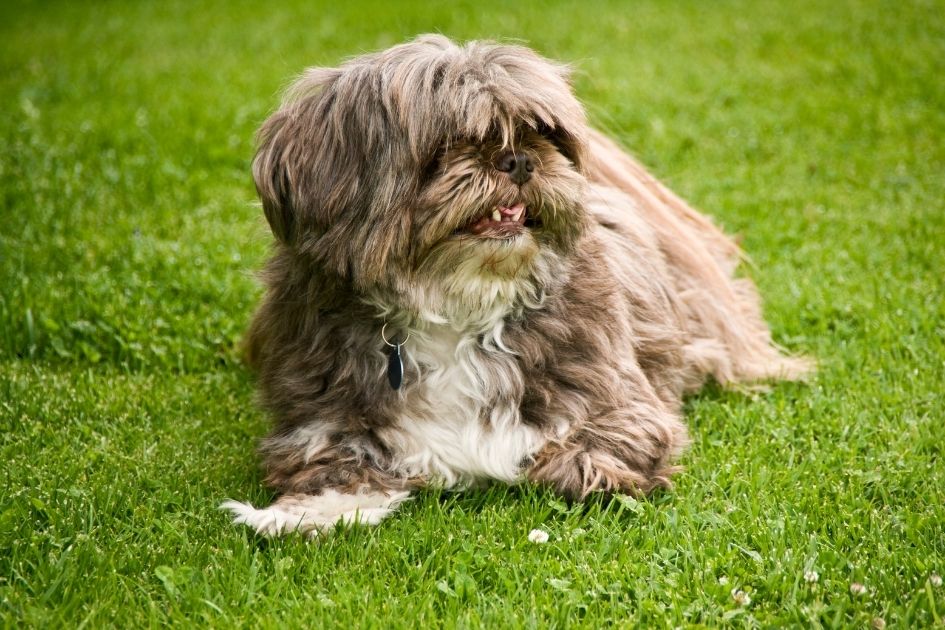
- Life Span: 12–15 years
- Height: Male 10–11 in; Female 9–10 in
- Weight: Male 13–15 lbs; Female 12–14 lbs
- Temperament: Playful, assertive, steady, intelligent, fearless, devoted
- Country of Origin: Tibet
Lhasa Apso is among the dogs with long hair, flowing like the Havanese. The drooping ears also contribute to making the Lhasa a dog that looks like a mop, granting them access to our list.
Lhasa is a small dog with a strong spirit and doesn’t let his size deter him from protecting his family. He’s highly devoted to his loved ones, and his fierceness leaves people astonished.
You can’t judge Lhasa by his size or apparent gentleness. When it comes to protecting, he turns to a warrior.
Lhasa has a natural suspicion of strangers, a leftover from his past years as a royal watchdog. This trait helps him play the watchdog role today, but you need to socialize him so it won’t turn into aggressiveness towards strangers.
This dog breed adapts to different environments and can even be a first-time dog. However, if you’re not firm during training, Lhasa may challenge your authority.
The breed was named after Lhasa, a holy city of Tibet. He once went by the name Abso Seng Kye, the “Bark Lion Sentinel Dog”.
Back then, he was a protector dog for monks and royals. The American Kennel Club recognized the Lhasa Apso in 1935.
13. Briard
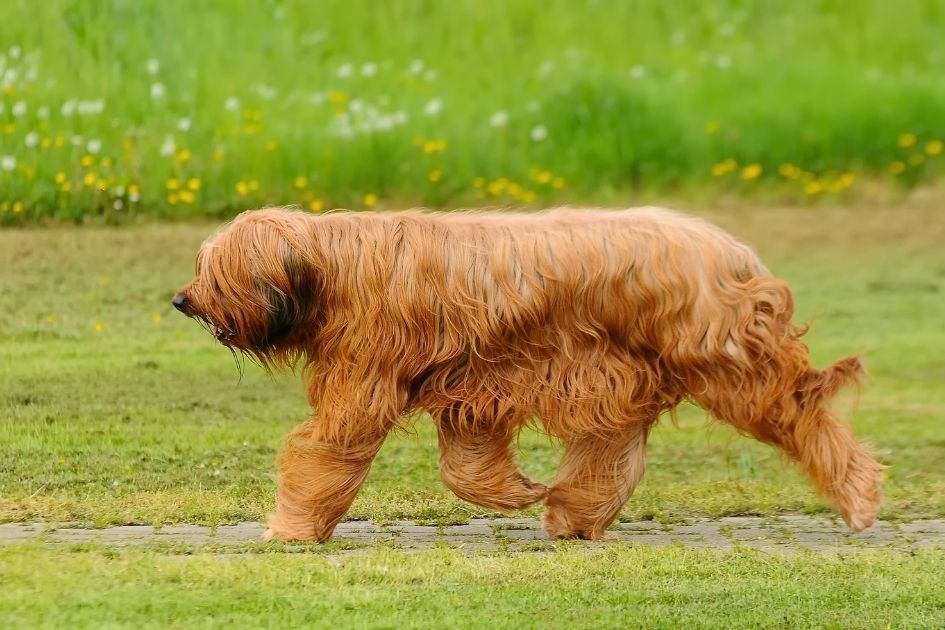
- Life Span: 10–12 years
- Height: Male 23–27 in; Female 22–25.5 in
- Weight: Male 70–90 lbs; Female 70–90 lbs
- Temperament: Faithful, intelligent, loyal, fearless, protective
- Country of Origin: France
The Briard is often called a heart wrapped in fur’, and he has a lot of that. A herder turned companion, briards have as much to offer at home as he did in the fields.
The Briard is a devoted family dog, and you will have to get used to having a shadow because he won’t leave your side. He isn’t too dependent, though, which makes him a good family dog.
Like many other herder dogs, he may try to keep his family in line by herding them. This is to be expected and can be curbed.
He is also suspicious of strangers, a good watchdog trait. You should socialize him, though.
Another trait he shares with other herder dogs is independent thinking. This makes him stubborn and sometimes resistant to training. You’ll need to be firm with him.
The Briard was once known as the Chien Berger de Brie, and has been with some historical personalities like Napoleon and Emperor Charlemagne.
14. Old English Sheepdog
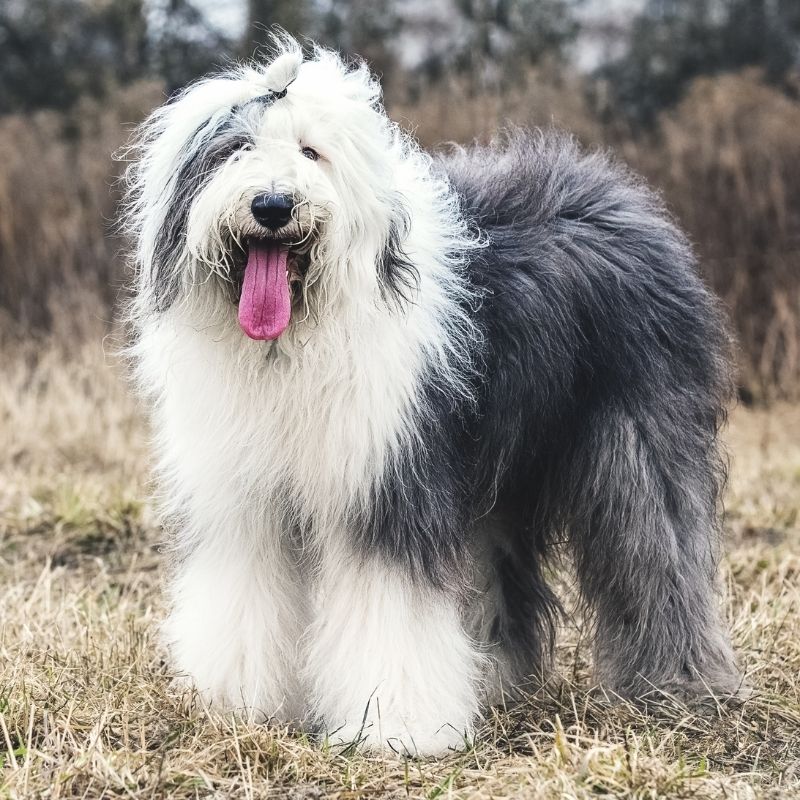
- Life Span: 10–12 years
- Height: Male 22 in; Female 21 in
- Weight: Male 80–100 lbs; Female 60–85 lbs
- Temperament: Intelligent, playful, loving, sociable, adaptable
- Country of Origin: England
The Old English Sheepdog (or OES) puts the S in Shaggy with his peculiar coat. He’s larger than many other dogs on this list, and currently plays the role of a household companion.
In a family setting, OES is easygoing, affectionate without reserve, and can even adapt to apartment living. Contrary to what you might think, the OES is a low shedder.
This breed is also good with children, so it’s no wonder they appear a lot in children’s shows.
While he is a protector who takes his job seriously, the OES also loves playing and is sometimes comical.
The few challenges you may face with this breed are exercise (if you’re not an active person) and some stubbornness he may display during training.
Though he has a blurred origin, the OES is believed to have originated from England where he served as a herder of cattle. The AKC recognized the breed in 1885.
- Life Span: 13–15 years
- Height: Male 22.5–25 in; Female 20.5–24 in
- Weight: Male 37–62 lbs; Female 37 to 62 lbs
- Temperament: Companionable, happy, obedient, intelligent
- Country of Origin: France
15. Barbet
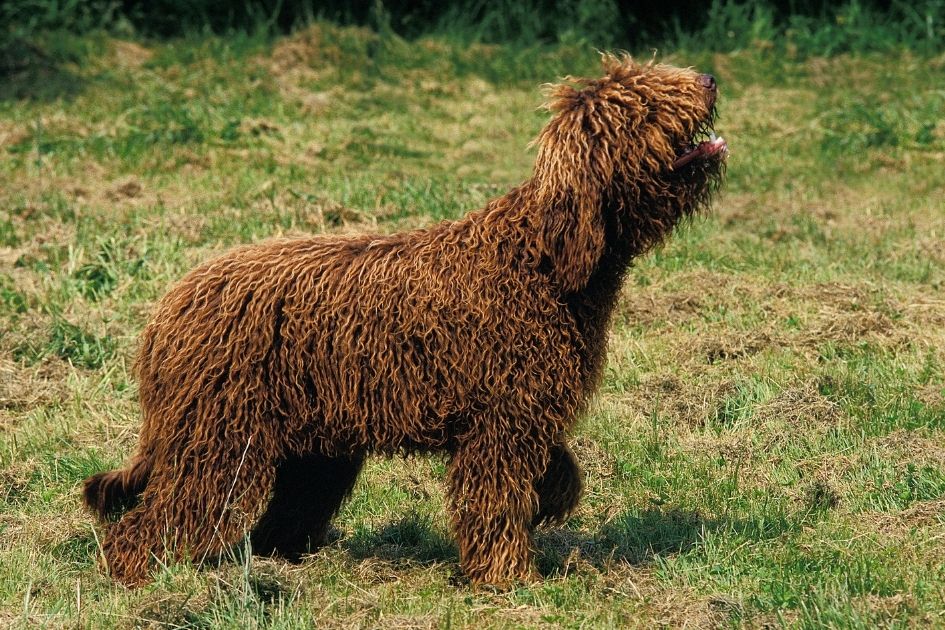
The Barbet is a close relative to two other dogs on this list: the Poodle and the Briard. He shares the same features and is the last dog on our list.
The Barbet has a joyful disposition that eased his transition from a water retriever to a family companion. He is also intelligent and is known to compete in agility.
It is a very rare breed, however, with only a few left in the United States.
He is not a new dog though. The Barbet has been around for centuries, earning the affection of some nobles like King Henry IV.
That said, the AKC recognized Barbet as a breed in 2020.
Can mop dogs see?
Many mop dogs have massive fur shielding their eyes. It adds to their overall appeal but makes many owners concerned if they can see.
The concern isn’t unfounded, as the fur over the eyes may make it difficult for dogs to see. You should trim it off to make life easier for your pet.
Why do mop dogs look like that?
Some mop dogs like Komondors and Pulik get the look from nature, and it is not much you can do to change that. Others need the interference of their owners, such as the Poodles and Havanese.
What breed of dog has dreadlocks?
There are some dog breeds with dreadlocks, giving off a Jamaican feel. The Puli is one such dog, as well as the Komondor.
Do Komondors hair naturally dread?
The Komondor doesn’t need their owners to intentionally give them a dreadlock. Left unhindered, the Komondor gets a dread through natural processes.
How much is a mop dog puppy?
Mop dogs are not as costly as others, but you do need to ensure you have enough. The average price for a mop dog is between $800 to $1,200.
Do mop dogs shed?
While most people may think otherwise, mop dogs do not have a high shedding need. Most of them hardly shed, and are good for people with dog allergies.
How do you care for a mop dog?
To care for a mop dog, you should make sure the hair doesn’t tangle up to a big cord that would be difficult to untangle. You don’t need a brush to do this.
Using your fingers, untangle the cords, then give them a massage to enable proper blood flow. Only use a brush when they are still puppies.
How to groom a dog with dreadlocks?
Grooming dogs with dreadlocks involves ensuring the dreads don’t turn into a mess. You need to keep the shaggy look without making them untidy.
Fortunately, most of them don’t shed much. You’ll only need to untangle the hair, trim on some occasions, and do other basic hygienes.
Wrap Up
And there you have it! These are the 15 best dogs that look like mops you can find out there.
While they do look special, remember there’s hardly anything special about them.
Dogs with dreads have the same needs as other dogs and present their challenges.
With expertise and commitment on your side, you will make your mop dog a good family companion.
You May Also Like: Top 30 Fastest Dog Breeds in the World (Try to Keep Up)

